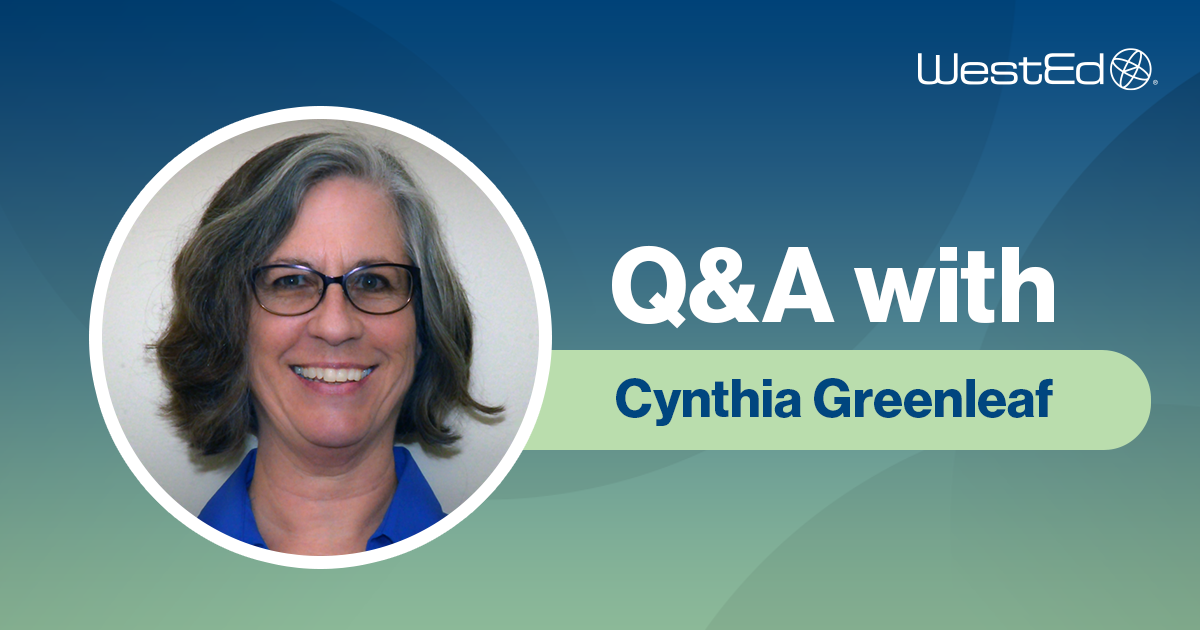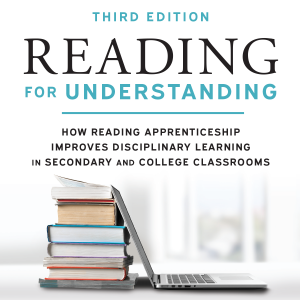Reflections on the Evolution of the Literacy Education Field
Posted on

Cynthia Greenleaf is a Senior Research Scientist in Literacy at WestEd. She co-developed the Reading Apprenticeship® Instructional Framework, which has transformed classrooms for countless students and teachers, and co-authored the seminal text in the field of literacy education, Reading for Understanding, now in its third edition.
An award-winning researcher, Greenleaf was most recently inducted into the Reading Hall of Fame, an honor bestowed by nomination to highly regarded leaders in literacy.
In this Q&A, she reflects on what has changed in the literacy field throughout her career, why Reading Apprenticeship remains relevant 27 years after its creation, and how the latest edition of Reading for Understanding can support teachers today.
You’ve carried out a breadth of research in professional learning and adolescent literacy over the past several decades. How has reading and teaching changed since you started this work?
Reading has always been critical to learning because it opens (or closes!) doors to success across every other aspect of life—from schooling to work to civic engagement. The field now recognizes the many forms of texts, such as narrative and exposition to graphs, diagrams, maps, photographs, and models, that readers encounter across disciplines. Each of these forms of text presents challenges to reader comprehension and students need support to learn how to work with them.
The explosion of texts in digital formats presents even more challenges, like managing distractions and discerning between real and “fake” information. Students need opportunities to learn how to handle these challenges, but support for teachers is thin these days.
In the 1980s, when I started this work, teachers were seen as professionals who could and did make curricular decisions and conduct assessments of student learning. In the past few years, teachers have weathered considerable stress as they shifted to emergency online teaching, hybrid teaching, and then back to the classroom again.
As social divisions have grown, teaching for equity, once a highly sought-after goal, has become deeply politicized. Many experienced teachers have left the teaching force, and in many places around the country, inexperienced adults with minimal training are now teaching children.
What kinds of support do teachers need today the most?
Teachers need recognition of their worth to society, respect for their work, and time to gain the knowledge and skills they need to advance student learning. They need collegial and administrative support, understanding for themselves and from facilitators and administrators of the emotional and identity work it takes to meet new challenges, and sustained support throughout their careers.
When we in Reading Apprenticeship treat teachers with respect for their intellect and engage them in deep professional learning over time, they’re often astonished to receive such recognition. We have written extensively about fostering deep professional learning, most lately in this chapter: https://readingapprenticeship.org/read-our-chapter-in-this-new-professional-learning-book/.
You’re one of the founders of Reading Apprenticeship—an approach to teaching and learning with a unique framework that integrates social–emotional learning and academic knowledge with “metacognition,” getting teachers and students to understand and make their thinking visible. How has the framework remained relevant for more than 27 years?
We began this work with an understanding of the social and emotional aspects of learning. We understood the importance of cultural knowledge, the ways variations in language and culture influence knowledge and learning, and how literacy itself and varied academic disciplines reflect specific social practices that students need to understand to be successful. In many ways, the field has been catching up with us over the decades.
Literacy is now understood to vary across academic disciplines. The role of social-emotional factors in learning is better understood, and SEL integrated into academic learning is seen as vital to student achievement. A new field, the Science of Learning and Development, articulates how culture and socially shaped experiences build specific knowledge, drive development, and sustain emotional involvement and personal agency in learning.
The framework has remained relevant in part because it started with a robust theory of learning, but also because it has been adaptive and subject to ongoing research and development over time. A broad learning community of experts has contributed to its relevance and growth and our professional learning model is inquiry-based, drawing on teacher expertise.
We study teacher implementers of Reading Apprenticeship and support inquiry networks in specific subject areas to learn how to best support disciplinary literacy. We listen to the field and participate in research endeavors and publish our work in professional peer-reviewed journals, with teachers as research partners and authors of this work.
Engaging teachers in helping to design and redesign learning ensures that this work is relevant and invests in the ownership and agency of teachers. As a result, we find that Reading Apprenticeship teachers become the leaders in their schools and districts and the most eager and discerning adopters of new reform initiatives as the field changes.¹
What’s new about the updated edition of Reading for Understanding?
The new edition includes a chapter on disciplinary inquiry, which shows how building Reading Apprenticeship routines into subject-area teaching can support the inquiry practices of the disciplines, such as scientific investigation, engineering design and testing, historical and literary argumentation, and mathematical modeling. We’ve also included more classroom examples of Reading Apprenticeship routines in varied subject areas and grade levels, including college. The voices of a more diverse set of teachers bring Reading Apprenticeship to life and illustrate the culturally sustaining aspects of the framework.
The new edition also includes the many insightful ways Reading Apprenticeship teachers are using digital texts and online teaching tools and supporting the development of critical media and information literacy. And of course, as in every edition, we have updated the evidence base and new research in the field that provides support for our framework. In addition to its evidence base and theoretical grounding, Reading for Understanding continues the tradition of guiding teachers on how to implement literacy instruction that is equity-based, discipline-specific, and informed by social–emotional learning.
How does the Reading Apprenticeship framework support learning acceleration?
While many approaches to literacy development focus on learning gaps and “deficits,” this framework is asset-based, helping both teachers and students see the resources and knowledge they already have, and how these are central to accelerating literacy and learning. We build on the considerable strengths and passions of students and teachers to advance complex and disciplinary literacy achievement. We center student voice and experience in classroom instruction, making student responses, understandings, and learning needs available to teachers as ongoing formative assessments.
Then, teachers are able to responsively adapt instruction to better draw on student strengths and meet student needs. The framework focuses on building students’ engagement in reading complex texts with sufficient teacher support to ensure success, which builds students’ literacy skills and knowledge while engaging in subject-area learning. The framework acknowledges students’ struggles with texts as well as their affective responses, making these resources central to drive learning in rich peer-to-peer discussion and shared problem-solving.
Throughout Reading for Understanding, we show teachers how to build students’ experience, confidence, engagement, tenacity, and accomplishment as they move students toward independence as readers of complex and challenging learning materials. If every teacher of every subject area in every school used this framework, students would receive five hours of literacy learning opportunities every day! Given this vision, we support teamwork among faculty members to provide a web of learning for students and offer a guidebook for literacy leaders to support this collegial approach.
Who are some of the Reading Hall of Fame members, and how do you feel about being in their company? Who did you “apprentice” with as you got started in the fields of professional learning, education research, and adolescent literacy?
I’m deeply honored to be inducted into the Reading Hall of Fame, having been nominated and voted into the organization by some of the greatest luminaries in the field. Members like P. David Pearson, Carol D. Lee, Sheila Valencia, Kathleen Hinchman, Peter Afflerbach, Judith Langer, Stuart McNaughton, Taffy Raphael, Georgia Garcia, Patty Anders, Elizabeth Moje, and Donna Alvermann have not only been my role models but my professional colleagues and friends.
My initial entry into the field began by learning about the inspiring work of such members as Kathy Au, Courtney Cazden, Luis Moll, Anne Marie Palincsar, and Shirley-Brice Heath. Virtually all members of the Reading Hall of Fame have served as college and university professors, so this award is a unique recognition of my work outside of “the academy” in schools and classrooms throughout my career at WestEd.
¹Greenleaf, Cynthia, Litman, Cindy, & Marple, Stacy. (2018). The impact of inquiry-based professional development on teachers’ capacity to integrate literacy instruction in secondary subject areas. Teaching and Teacher Education, 71, 226–240. https://doi.org/10.1016/j.tate.2018.01.006. This publication reports on an observational study analyzing literacy learning opportunities during classroom lessons offered by secondary ELA, history, and science teachers. Conducted as part of the U.S. Department of Education’s Reading for Understanding initiative, the study compared lessons of teachers who had previously participated in Reading Apprenticeship professional learning to those who had not. It showed that Reading Apprenticeship successfully prepared teachers to engage thoughtfully in new reforms and innovations and to become leaders in their subject areas when new standards emerged years after their professional learning experiences.

